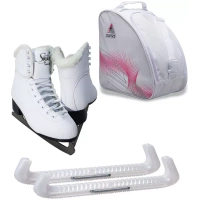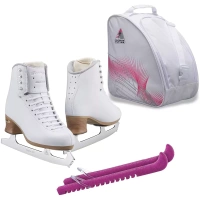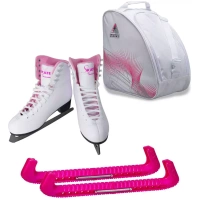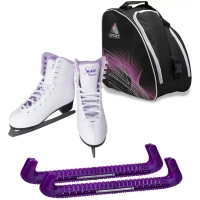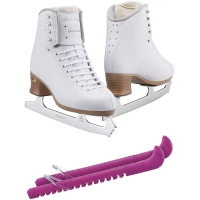In ice hockey, the skates are an essential part of the game, as they influence the player’s performance greatly and add to the overall feeling of comfort and confidence. Getting the skates to fit perfectly is the key to success. A skate that doesn’t fit perfectly will make the player uncomfortable, will not provide enough ankle support, will cause blisters, or can even cause players to lose interest in the game. Here is what you should learn about fitting hockey skates, taking measurements and breaking in new skates.
How to properly size the perfect hockey skates?
If you are buying your first ice skates, the first question you have is ‘What size ice skates should I choose?’ It all depends on the brand of the skates. Generally, hockey skates’ size is 1 to 1.5 sizes smaller than your shoe size. It still differs between manufacturers, but you should know that you won’t have the same size in walking shoes and ice skates.
Skates have a lot of different features to consider. When you are looking for the right ice skates, there is a lot to consider. Your ice hockey skates should match your skate size, skate width, depth / arch, your weight, as well as your skating ability / style / playing level.
There are different fits offered by different companies. If you are a size 10 in one brand, you might fit into size 9 or 8.5 in another one. It comes from the differences in the skate width, toe width, the depth of the skate, the volume in the heel, etc.
Here are some vital tips to find the right hockey skate fit.
At the hockey skate fitting, you should wear the socks you are going to wear for the practice and games. If your heel is moving or you can lift it, that means that the skate doesn’t fit well and your performance will suffer. The skate should fit snug and provide support to your feet. It enables a good push-off without unnecessary movement of the foot inside the skate.
It takes some time to break into new ice skates. Heat fitting is a great option that facilitates the break-in process and helps get a proper hockey skate fit. The skates are baked in a special oven to round out the stiff sides and the boots’ upper part. This way, they take the shape of the player’s feet and ensure a proper hockey skate fit. Heat molding your hockey skates shortens the break-in time by about a half.
There is much more to learn about finding the right size of ice skates. Check out our article about taking measurements and fitting your skates.
Should it hurt the first time I use skates?
A little discomfort is normal for your first skate in new skates. It is also OK to get a blister or a bit of a pain. However, this kind of discomfort should only occur in the first couple of times you use the new skates. It is a normal process of breaking in a new pair of skates. After you have broken in your new skates, you shouldn’t experience any pain or get blisters during skating. If that happens, look for the reason: it can be the wrong size of boots, improper socks, or faulty lacing.
How long will it take to break in a new pair of ice skates?
If you have worn the skates more than ten times and it still hurts, then there is a problem. Either your skates do not fit you properly, or you have a special shape of feet that needs attention. The solution will depend on the kind of problem. If the skates do not fit perfectly, you can customize the skates by adding special insoles, or take them to a professional to have them ‘punched’. If you happen to have extra-wide ankles, you can have the sides of the skates punched to get more room.
How to properly tie ice hockey skates?
Just like regular shoes and boots skate, laces need to hold your tongue in place. This is where lacing can get a bit tricky since the top of the skate often wants to loosen up instead of staying tied down. To make it easier, first, loosely tie the laces all the way to the top, then using two fingers, one from each hand, start pulling the laces tight from the bottom up. You will need to maintain a little bit of pressure on the laces you have just tied, as they will loosen up.
Properly tied laces can affect how you escape as well as how much support your skate gives you. Take your time to keep your lace as tight as you tie them further towards the top. If it takes you two-three times to get your laces properly tied, that’s perfectly OK. It is important to make sure you always tie your laces right to the top since it gives your ankles more support while skating. If you have extra lace leftover, you can wrap it around your ankle before tying the knot. Some players like to tie the knot first, and then wrap a few rounds of tape around their ankles for added support and protection. Some people’s ankles naturally want to bend in towards the ice. There’s a skate tying trick that can provide even more added support. Instead of crossing your top two eyelets the hole the laces, go through go directly up to the next eyelet above to create a loop with the lace. Then bring the laces from the opposite side through the loops and pull. You will notice the laces are now pulling the boot much more tightly around the ankle.
Your skates should never hurt your feet when lacing them up or when skating. If it happens, your skates are either laced up too tight or are too small.
Check out our guide to lacing ice hockey skates. (Insert a link to the article ‘How to Lace Hockey Ice Skates’).
Some tips that will improve your ice skate lacing.
- Unlace the boot all the way down. This way, you will release the tension at the boot and prolong its perfect fit. Do not leave boots laced in a hot place, as they could deform.
- Do not wear heavy socks. They will disturb the fit of the skate and distort the feeling of the boot. Go with a pair of trouser sock or knee-highs. Avoid cotton socks, because they will absorb all the moisture from your feet and become uncomfortable.
- Keep your ice skates dry. After taking them off, wipe the blade and underside of the boot to dry them out. To avoid the rust, store them with dry soakers on the blades.
- If after the lace-up you feel that the skates are too loose, you should redo the lacing. Do not get lazy, as unstable ankles are a direct way to injury.
- Figure skates should not be too tight. If you have difficulty bending knees, go back and re-tie them.
- Make sure the skate tongue is straight and does not slip under the laces.
- Skates must fit properly. If the boot is too big, tight lacing will not improve the skating experience. Learn how to measure your feet and find the right size of ice skates here.
